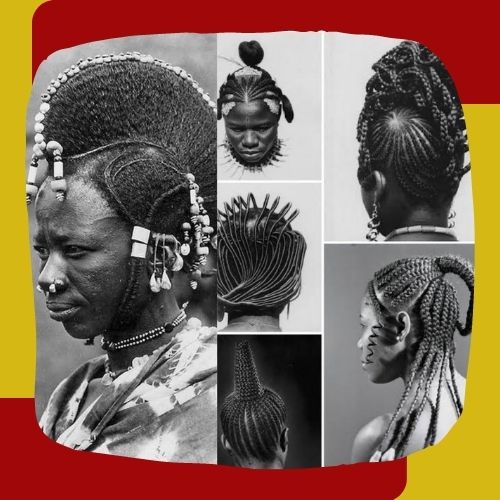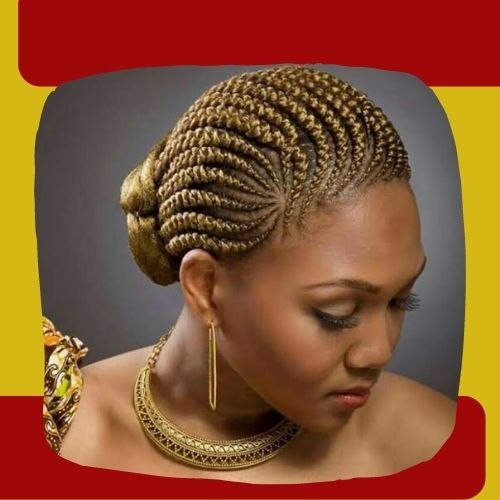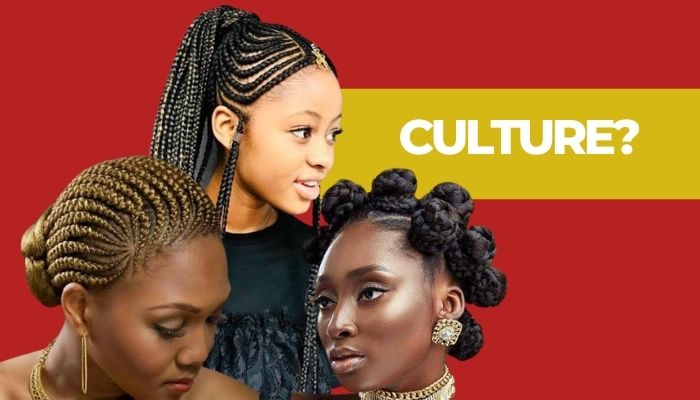Yes, Braids is black culture. You can call it black culture because it originated from black people and was first seen in them. Braids or plaits are two to three strands of hair interlaced or woven together. Braids are now plaited in different styles like cornrows, box braids, Ghana weaves, etc.
It is also worn by males and females of different nations and tribes and it is sometimes hard to place its origins, but it does have an origin. Braids that are now all trendy and stylish were the cultural and traditional statement of a people — the blacks. While it is just a hairstyle or trend for most people, it holds past experiences and the history of black people.
You’ll get to see braids a little different from what you’ve known them to be as you read on.
History of Braids

The advancement in fashion, as well as technological innovations, brought lots of changes to our cultural heritage. This happen to have impacted braids, such that we could almost not tell it’s the origin
Ancient paintings and other cultural artifacts reveal black women wearing braids as far back as the 15th century. However, Braids have evolved in such a way that you could see it as a regular hairstyle done by people across borders, even on white celebrities. But there is more to the hairstyle that is known to all.
Braids in earlier times weren’t just a hairstyle, it was a means of identifying a person’s social and marital status, tribe, wealth, clan, and even age.
In the early days when Africans braided their hair, it was done carefully to avoid passing a wrong notion about the person on the hairstyle. In Ancient Egypt for instance, women of high status heavily adorn their braids with beads while the commoners wore plain braids.
Here is one braid identity fact. Previously any woman wearing five long braids down the back with a small tuft of hair gathered at the top of the crown was easily known to all as a Fula from the Sahel region.
Hairstyles in those days were not just for beautification, they had other functions as well. For instance, during the time of colonization, African women that were captured as slaves usually devised their escape plan secretly through their braids. Those braids were called “map to freedom”. Isn’t that amazing?
Braids were the major if not the only hairstyle of the blacks then. Anyways, versatility wasn’t popular then, so it was just braided. However, fashion has radically evolved, so you can see a wide variety of braid hairstyles.
Popular Braiding Styles
Braids have been in existence for hundreds of years, yet it’s a mystery how it trends till today. The braids hairstyle handed down has been so modified such that it can be styled not less than 20 different ways.
This past cultural symbol of blacks is now a fashion trend for people of different tribes and races. Braids are now popularly accepted and loved, a hairdo that was previously considered old-fashioned.
In years past, black ladies in America could not proudly flaunt braids, as it was mocked and unaccepted. But the reverse is the case, as Braids aren’t hidden anymore, rather, they now come in more beautiful styles. Here are some of them;
1. Cornrows

Cornrow is a simple but beautiful braid hairstyle. The dry hair texture of most African ladies encourages this hairstyle. It is a protective hairstyle as it helps the hair retain moisture which prevents breakage and fastens its growth.
Cornrows are now so beautifully made that they can be worn wherever! They can be made more exotic by adding beads.
2. Box Braids

Box braids are also referred to as “Bob Marley ” in some parts of Africa. This is because it is similar to the braids worn by the popular South African musician, Bob Marley. While cornrows are held tightly to the scalp and plaited down the scalp, Box braids are plaited in individual strands and left to dangle.
Box braids are also similar to the Eembuvi braids of Namibian women or the chin-length bob braids of the women of the Nile Valley from over 3,000 years ago. They can now be made in various lengths and sizes based on choice. However, bear in mind that box braids take a lot of time to be made.
3. Bantu Knots

Bantu Knots! This is one of the braid hairstyles worn by the popular music artist, Rihanna. It originated from Africa, precisely from the Fulanis. Bantu knots are a very creative but not-so-regular hairdo.
This style of braids makes any individual on the hairstyle stand out. Bantu knots can be made with your natural hair or out-of-box braids.
4. Ghana Weaves/ Braids

Ghana weaves are patterned like cornrows, however, they look a bit different from it. They are plaited just as cornrows, but with extensions which makes them bolder and more stylish than cornrows.
Ghana braids also referred to as “straight back”, or “banana braids” can also be made into a bun, an updo, and various other styles.
5. Senegalese Twists

These twists are very beautiful and stylish. It is interwoven in threes at the root and then twisted in twos to any desired length. These twists can be done loosely or tight. The image displays a loosely braided twist – known as the Senegalese twist.
5. Fulani Braids

Fulani Braid is another hairstyle that is rooted in Black culture. These braids were popular amongst the Fulani and were characterized by beads and jewelry. Wealthy Fulani women wore their braids with exotic jewelry and beads. Although in modernized times, the beads aren’t attached as much as it was on the Fulanis.
6. Knotless Braids

Knotless Braids are one of the trending braid styles. It is plaited like box braids, but in a unique way that makes it stand out from Box braids. It often begins with your natural hair at the root, and then a fair extension is added almost immediately.
They are also made in different lengths and sizes. Knotless Braids are more beautiful when accessorized with beads.
Frequently Asked Questions (FAQs)
Why do Africans Braid Their Hair?
Africans wear braids for beautification and also to serve as a protective measure for the hair. Native blacks often wear them as a symbol of identity, status, ethnicity, etc. Braids for Africans were a cultural symbol and social art that unites the female folks.
Why is Hair so Important in Black Culture?
Hair is considered a woman’s bride, identity, and beauty in black culture, and also holds in other cultures. It is also a symbol of the black’s strength and uniqueness.
In earlier times, if a black woman were to shave her hair, it was considered a thing of shame to her. And when such happens, they often cover their hair with long scarves until it’s well-grown.
What does Braided Hair Symbolize to Blacks?
Braided hair represents various things to different black tribes. It symbolizes a form of communication, societal status, unity, wealth, freedom, peace, age, acceptance, and strength.
It’s Your Turn
Braids are originally black-cultured! Black ladies no longer feel ashamed of this cultural heritage as they can now flaunt different braids styles with pride.
So, what’s your view on braids? Have you seen a braid style you would like to try out the next time you visit the salon?
